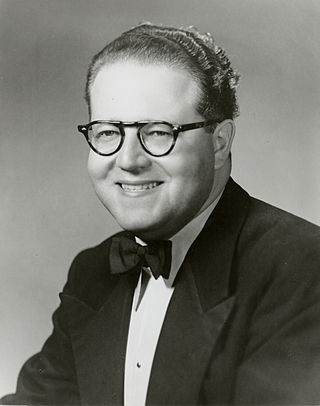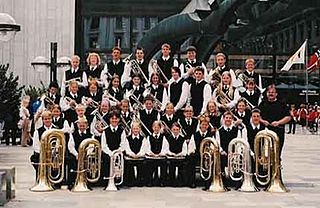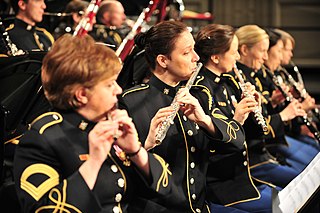Related Research Articles

A musical ensemble, also known as a music group or musical group, is a group of people who perform instrumental and/or vocal music, with the ensemble typically known by a distinct name. Some music ensembles consist solely of instrumentalists, such as the jazz quartet or the orchestra. Other music ensembles consist solely of singers, such as choirs and doo-wop groups. In both popular music and classical music, there are ensembles in which both instrumentalists and singers perform, such as the rock band or the Baroque chamber group for basso continuo and one or more singers. In classical music, trios or quartets either blend the sounds of musical instrument families or group instruments from the same instrument family, such as string ensembles or wind ensembles. Some ensembles blend the sounds of a variety of instrument families, such as the orchestra, which uses a string section, brass instruments, woodwinds, and percussion instruments, or the concert band, which uses brass, woodwinds, and percussion.

The saxophone is a type of single-reed woodwind instrument with a conical body, usually made of brass. As with all single-reed instruments, sound is produced when a reed on a mouthpiece vibrates to produce a sound wave inside the instrument's body. The pitch is controlled by opening and closing holes in the body to change the effective length of the tube. The holes are closed by leather pads attached to keys operated by the player. Saxophones are made in various sizes and are almost always treated as transposing instruments. A person who plays the saxophone is called a saxophonist or saxist.

Alfred Friedman was an American neoclassical composer, with more than two hundred published works for concert band, orchestra, chorus, and chamber ensemble to his name. He also traveled extensively as a guest conductor, performing in North America, Latin America, Europe and Asia.
The alto clarinet is a woodwind instrument of the clarinet family. It is a transposing instrument pitched in the key of E♭, though instruments in F have been made. In size it lies between the soprano clarinet and the bass clarinet. It bears a greater resemblance to the bass clarinet in that it typically has a straight body, but a curved neck and bell made of metal. All-metal alto clarinets also exist. In appearance it strongly resembles the basset horn, but usually differs in three respects: it is pitched a whole step lower, it lacks an extended lower range, and it has a wider bore than many basset horns.

A school band is a group of student musicians who rehearse and perform instrumental music together. A concert band is usually under the direction of one or more conductors. A school band consists of woodwind instruments, brass instruments and percussion instruments, although upper level bands may also have string basses or bass guitar.
Václav Nelhýbel was a Czech American composer, mainly of works for student performers.
Walter Sinclair Hartley was an American composer of contemporary classical music.

Frank Ticheli is an American composer of orchestral, choral, chamber, and concert band works. He lives in Los Angeles, California, where he is a Professor Emeritus of Composition at the University of Southern California. He was the Pacific Symphony's composer-in-residence from 1991 to 1998, composing numerous works for that orchestra. A number of his works have become standards in concert band repertoire.
Warren Benson was an American composer. His compositions consist mostly of music for wind instruments and percussion. His most notable piece is titled The Leaves Are Falling (1964).
Music for Prague 1968 is a programmatic work written by Czech-born composer Karel Husa for symphonic band and later transcribed for full orchestra, written shortly after the Soviet Union crushed the Prague Spring reform movement in Czechoslovakia in 1968. Karel Husa was sitting on the dock at his cottage in America at the time, listening to the BBC broadcast of the events on the radio. He was deeply moved, and wrote Music for Prague 1968 to memorialize the events. This piece is a standard among wind ensemble repertoire.
The First Suite in E♭ for Military Band, Op. 28, No. 1, by the English born and raised and composer, Gustav Holst is considered one of the cornerstone masterworks in the concert band repertoire. Officially premiered in 1920 at the Royal Military School of Music, the manuscript was originally completed in 1909. Along with the subsequent Second Suite in F for Military Band, written in 1911 and premiered in 1922, the First Suite convinced many other prominent composers that serious music could be written specifically for band.
The Second Suite in F for Military Band is Gustav Holst's second of his two suites for concert band. Although performed less frequently than the First Suite in E♭, it is still a staple of the band repertoire. The Second Suite, written in 1911 and first published in 1922, dedicated to James Causley Windram, is longer and considered more difficult to play than its sister suite.
October is a contemporary piece for concert band that was written by Eric Whitacre in 2000. Based on the guidelines as established by the authors of Teaching Music through Performance in Band, October is a Grade 5 piece.

Colonial Song is a musical composition written by Australian composer Percy Grainger. Although Grainger created versions for different types of musical ensembles, its most commonly used version today is for concert band.
Composed in 1957, Symphonic Songs for Band is one of Robert Russell Bennett's most famous compositions for wind band. The work was commissioned for the National Intercollegiate Band by Kappa Kappa Psi and Tau Beta Sigma, national honorary band fraternity and sorority, as part of the two organizations' commissioning program. Since its premiere, it has become among the most frequently performed works in the wind band repertoire. It is considered to be a cornerstone of the band literature.

The woodwind section, which consists of woodwind instruments, is one of the main sections of an orchestra or concert band. Woodwind sections contain instruments given Hornbostel-Sachs classifications of 421 and 422, but exclude 423
Junior Durward Morsch was an American composer, prolific arranger, trombonist, and retired music educator who has worked and recorded professionally in a broad spectrum of genres, beginning with progressive big band jazz in the late 1940s and ending as a high school band director in Colorado. He was also the band director at Saguaro High School, in Scottsdale, Arizona.
Clare (Ewing) Grundman was an American composer and arranger.
John Zdechlik was an American composer, music teacher, and conductor. He was elected to the American Bandmasters Association and many of his compositions became standard concert band repertoire, including Chorale and Shaker Dance.

Robert Lemay is a Canadian composer of solo, chamber and orchestral works.
References
- ↑ Smith, Norman E. (2002). Program Notes for Band. GIA Publications. p. 663. ISBN 978-1579991470.
- ↑ Garafalo, Robert J. (1999). Chorale and Shaker Dance (Masterworks Instructional Series). Meredith Music Publications. ISBN 978-1574630732.
- ↑ A Composer’s Insight, Volume 3: Thoughts, Analysis and Commentary Masterpieces for Wind Band, Salzman, Timothy (Ed.). Meredith Music Publications: Galesville, MD, 2006, ISBN 978-1574630480